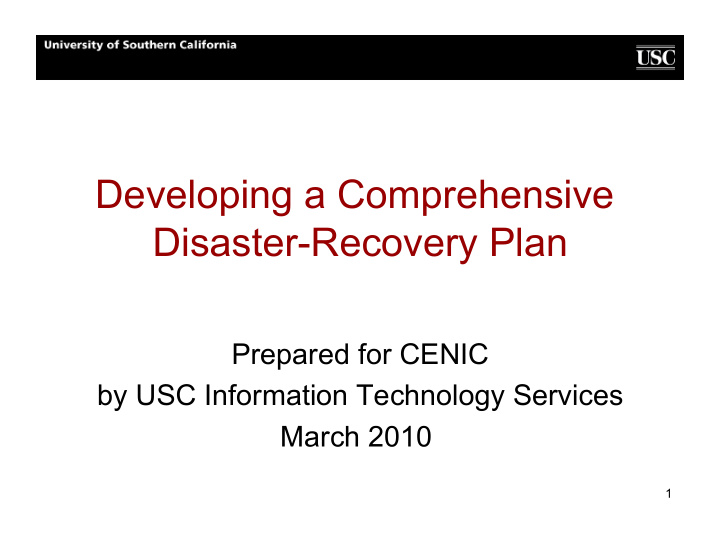



Developing a Comprehensive Disaster-Recovery Plan Prepared for CENIC by USC Information Technology Services March 2010 1
Why Business Continuity and Disaster Recovery? We want to provide continuous service and improved backup for mission-critical systems and normal business operations. USC is located in Southern California, where there is a significant risk of a large earthquake in the near future. There is also concern that an outbreak of flu could require faculty, students, and staff to work remotely for 1 to 3 weeks. 2
USC Goals For Business Continuity: • critical teaching functions to be restored as soon as feasible (within 7 days) • critical research functions to be restored as soon as feasible (within 14 days) For Disaster Recovery: • identified ITS services to be restored within required timeframes 3
Business-Impact Analysis ITS is working with a certified business-continuity specialist to: 1. Conduct a business-impact analysis. 2. Evaluate business-recovery strategies. 3. Develop the business-continuity plan. 4. Maintain that plan on an ongoing basis. 5. Test that plan annually. 4
Critical ITS Business Functions • USC emergency website • University’s phone operators • University’s voice network service • ITS Network Operations Center • Internal data network service • External data network service • Security of information • Web-based communications systems (continued) 5
Critical ITS Business Functions • Customer support center & communications services • ITS purchasing • Enterprise systems, disk storage, student information systems, and related facilities • Colocation services • Online educational technology applications (including Blackboard) • ITS timekeeping and payroll (continued) 6
Critical ITS Business Functions • Support for classroom labs, multimedia classrooms, and computer centers • Audio/video conferencing services • USC’s Center for High-Performance Computing and Communications (HPCC) • Support for the USC Shoah Foundation Institute video archives • ITS budget administration 7
Business-Continuity Planning ITS is identifying those core services that require the attention of key staff members. To mitigate risk, ITS is developing contingency plans by service, including: • Improved documentation. • Cross-training of staff. • Development of telecommuting options and guidelines. 8
ITS Disaster-Recovery Tier-1 Services Timeframe: online within 24 hours of a disaster with no more than 24 hours of data loss. • critical to ITS business processes, or • critical to university infrastructure, or • critical to teaching, or • critical in order for other departments’ critical business processes to function and/or vital records to be accessed. • examples: authentication, student information system, email, and Blackboard 9
ITS Disaster-Recovery Tier-2 Services Timeframe: online within 7 days after disaster. • critical to research, or • critical in order for other departments’ critical business processes to function and/or vital records to be accessed, or • non-critical but necessary services supporting ITS’s infrastructure or service offerings, or • identified as non-critical but necessary services supporting other departments. 10
ITS Disaster-Recovery Tier-3 Services Timeframe: online within 14 days after disaster. • supporting ITS’s infrastructure or service offerings, or • non-critical secondary services supporting other departments’ operations. 11
ITS Disaster-Recovery Tier-4 Services Timeframe: unlikely to be brought up in the short- term following a disaster; online within months of a disaster. • considered necessary for normal operations, but not considered necessary for short-term, post-disaster operations, and • downtime-tolerant. 12
ITS Disaster-Recovery Site and Network Design Considerations • Bandwidth • Cost • Redundancy • Last-mile challenges • Disaster-recovery site is geographically distant enough to be outside of a likely earthquake zone and still within driving distance • Cold storage site is on the U.S. East Coast 13
ITS Disaster-Recovery Site Design Disaster-Recovery Site: Primary Location: Offsite Location 1 USC Data Center Disaster-recovery ITS enterprise services implementation of Tier-1 ITS enterprise services Failover governance Networking between sites Infrastructure architectural design Staffing and procedural dependencies Cold Storage Site: Offsite Location 2 Tape storage for non-immediate data restoration 14
Service Interdependencies Both system and business-process interdependencies need to be identified early as part of the disaster-recovery planning process. Interdependencies must also be reflected in the restoration-process design. 15
Critical ITS Tier-1 Enterprise Services Connectivity, load balancers, console USC main web server, portals, blogs, content aggregators, network management, fiber management systems and other web- channel service, backup/restoral based communication services management tools and metadata USC enterprise email services including System, disk array and network monitoring Google Apps for students and performance alert tools Learning management system and grading roster tools Domain Name Service (DNS), Network Time Protocol (NTP) Student Information System (SIS) and Network Information Service (NIS), shared associated applications: directories, networking, wireless, and Document management, admissions, systems databases and services prospective students’ portal and (including DHCP) application management tools, enrollment, Databases, database management services, schedule of classes, course registration, and related middleware applications degree audit reporting system, advisement, curriculum and bookstore Accounting, accounts management and services, and associated connectors to related databases, affiliate accounts and e-pay service password management, and first login ITS website, ticket request tracking, customer Person Registry (PR), Global Directory service and knowledgebase tools Service (GDS), Kerberos, Lightweight Directory Access Protocol (LDAP), and Tools and services required by regulatory Shibboleth (single sign-on) agencies 16
Critical ITS Tier-1 Enterprise Service Interdependencies Primary Location Disaster Recovery Site Cold Storage Site Business Dependency Technical Dependency A B “B is dependent on A” 17
http://cst.usc.edu/services/emergencyprep.html 18
Faculty Survey Response 19
Teaching with Technology Incentive Grants Funding to faculty to develop a 1-to-3-week active learning assignment, accessible via Blackboard learning management system. • Assumes basic network connectivity, electricity, and Blackboard availability. • Aligns with the Provost's Emergency Preparedness initiative. • Includes a course design and implementation planning workshop led by the Institute for Multimedia Literacy and the Center for Scholarly Technology (CST). • Includes an assessment and evaluation workshop and consultations led by CST and the Center for Outcomes Research and Evaluation. 20
Closing and Discussion For additional information concerning this presentation: Adele Shakal, adele@usc.edu ITS Information Technology Project Office Ken Mills, kenmills@usc.edu Senior Communications Engineer 21
Recommend
More recommend